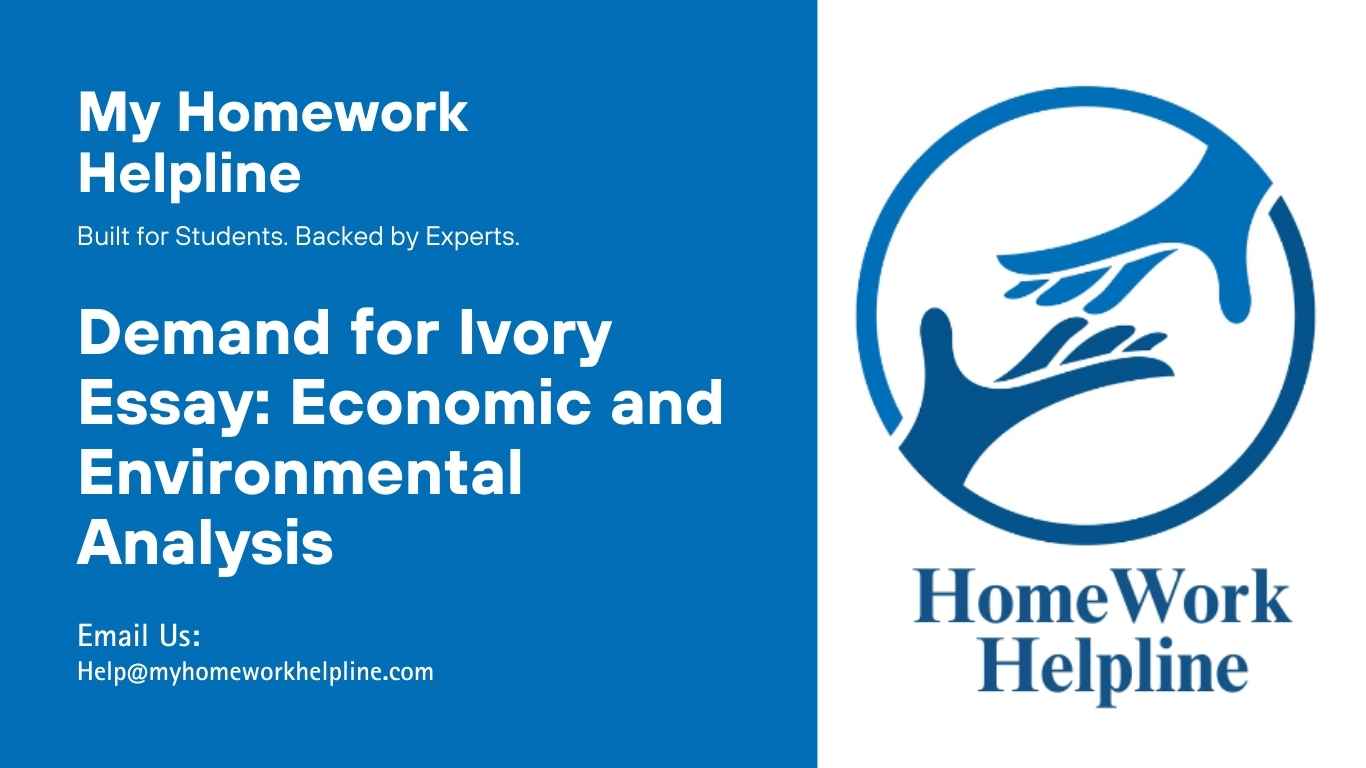Demand for Ivory Essay: Policy Impacts on Poaching, Supply, and Conservation
There are serious consequences for elephant populations if the ivory trade continues. Some nations have recently instituted laws to stop the illegal ivory trade, including destroying all seized ivory. The availability of ivory on the market has decreased due to these measures, but there is growing fear that this may enhance the motivation for poaching. In this essay, presuming that a new policy allowing countries to sell captured ivory instead of destroying it will not affect demand for ivory, we will examine the policy’s potential impact.
Understanding essays that analyze complex issues like ivory demand requires clear research and structured writing. If you’re working on a similar assignment and need reliable guidance, our homework assistance service can support you with expert insights and polished academic writing. Whether it’s economics, environmental studies, or data-driven analysis, we’ll help you complete your essay with accuracy and confidence.
Analysis 1: No Effect on Demand for Ivory
The impact of the new regulation on elephant poaching can be estimated using supply and demand analysis, assuming that the demand for ivory is unaffected by the policy change. If countries that have previously destroyed captured ivory began selling it instead, the supply curve would move to the right. Because of this rise in supply, the price of ivory would drop, and the demand for it would rise. However, to what extent this strategy might reduce the poaching of elephants depends on how elastic the demand is for ivory. If there is a high degree of price elasticity between supply and demand for ivory, a price drop would lead to a surge in demand, possibly increasing the incentive for poaching (Taboola). If demand is inelastic, however, the strategy may have little effect on elephant poaching because the resulting rise in the amount demanded would be minimal. The policy’s effect on elephant poaching would similarly be proportional to the extent to which supply is increased. The policy’s efficacy in reducing elephant poaching may be limited if the increase in supply is small (University of Bristol). However, if the increase in supply is large, it may significantly affect the price and quantity requested, boosting the incentive for poaching.
Analysis 2: Effect on Demand for Ivory
The new policy would affect the demand for ivory. It has been speculated that the price of ivory may fall and the demand for it rises if governments who have historically destroyed captured ivory begin selling it on the market. The policy’s influence on the demand for ivory would be conditional on several circumstances. At first, the role of the price elasticity of demand for ivory is essential. A price drop could boost the motivation to poach if there is a high degree of price elasticity between supply and demand. If demand is inelastic, however, the strategy may have little effect on elephant poaching because the resulting rise in the amount demanded would be minimal.
The policy’s effect on ivory demand would be influenced by people’s tastes and perspectives on the illegal ivory trade. A drop in demand for ivory may make customers more aware of the detrimental effects of the trade on elephant conservation if the policy were extensively advertised and seen as legitimizing the trade in ivory (The Economist). Nevertheless, if this approach is seen as a method to supply a legal source of ivory, it could boost demand for ivory and the motivation for poaching. Ultimately, the policy’s effect on elephant poaching would be determined by the size of the increase in supply and the subsequent effect on the price and quantity demanded. The policy’s efficacy in reducing elephant poaching may be limited if the increase in supply is small (Kelly). Since if the increase in supply is large, it may significantly affect the price and quantity requested, perhaps boosting the incentive for poaching.
An increase in demand for ivory, as would result from the proposed policy to legalize the selling of seized ivory, would almost certainly lead to a rise in the illegal killing of elephants for their ivory. It would happen because the market would have a larger supply of ivory, resulting in a lower price. Nevertheless, if this policy were implemented in tandem with serious attempts to lower demand, it might help reduce the number of elephants lost to poaching. In sum, this policy’s implementation is a tricky business that requires considerable thought and deliberation across various economic and environmental concerns.
Works Cited List
Kelly, Morgan. “After Legal-ivory Experiment, Black Markets Thrive from Greater Demand, Less Risk.” Princeton University, 16 June 2016. https://www.princeton.edu/news/2016/06/14/after-legal-ivory-experiment-black-markets-thrive-greater-demand-less-risk#:~:text=In%20the%20case%20of%20ivory,skins%20by%20adequately%20meeting%20demand.
Taboola. Myanmar Burns Ivory, Skins to Fight Illegal Wildlife Trade. 4 Oct. 2018, https://apnews.com/article/02ce4dca067d4fe787880d1c4ca13f06
The Economist. “Up in Smoke.” The Economist, 8 Feb. 2014, https://www.economist.com/international/2014/02/08/up-in-smoke
University of Bristol. INCREASING VALUE OF IVORY POSES MAJOR THREAT TO ELEPHANT POPULATIONS. 30 Nov. 2019, www.savetheelephants.org/about-elephants-2-3-2/elephant-news-post/?detail=increasing-value-of-ivory-poses-major-threat-to-elephant-populations

